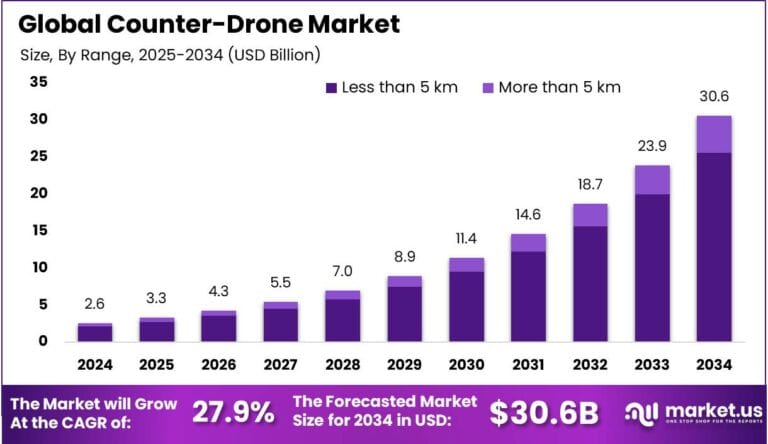Table of Contents
Introduction
The global counter-drone market is forecasted to expand from USD 2.61 billion in 2024 to USD 30.6 billion by 2034, exhibiting a remarkable CAGR of 27.9%. In 2024, North America led with a 43.7% market share, generating approximately USD 1.14 billion. The U.S. segment accounted for USD 1.02 billion, growing at a CAGR of 26.7%. This rapid growth is driven by escalating security threats, increased drone usage in military and civilian sectors, and rising investments in advanced detection and mitigation technologies globally.

How Tariffs Are Impacting the Economy
Tariffs on key components used in counter-drone technologies, such as sensors, radar systems, and communication equipment, elevate manufacturing costs. These increased costs translate into higher prices for defense contractors and government agencies, potentially limiting procurement volumes. Inflationary pressures from tariffs reduce budgets and delay modernization projects.
➤ Discover how our research uncovers business opportunities @ https://market.us/report/counter-drone-market/free-sample/
(Use corporate mail ID for quicker response)
Supply chain disruptions caused by tariffs force companies to diversify suppliers or relocate production, often at increased operational expenses and longer lead times. Retaliatory trade measures add geopolitical tension and market uncertainty, deterring investments and innovation. Collectively, tariffs slow the deployment of critical counter-drone systems, impacting national security and defense readiness.

Impact on Global Businesses
Counter-drone solution providers face rising costs and supply chain complexities due to tariffs on specialized electronic components. Defense contractors experience procurement delays and higher capital expenditure, affecting project timelines. Commercial security sectors face barriers to adopting advanced counter-drone technologies, limiting market penetration. Emerging markets reliant on imports face affordability challenges and slower technology uptake. These pressures compel companies to optimize supply chains, invest in modular and scalable solutions, and engage in strategic partnerships to maintain competitiveness amid tariff-induced volatility.
Strategies for Businesses
Businesses mitigate tariff impacts by diversifying suppliers and enhancing regional manufacturing capabilities. Investment in modular, software-driven counter-drone systems reduces dependency on hardware. Predictive analytics aid in forecasting tariff changes and optimizing inventory management. Collaborations with governments and defense agencies improve market access and operational resilience. Emphasizing automation and innovation drives cost efficiency. Advocacy and engagement in trade policy discussions support favorable environments. Agility, technological advancement, and partnership are key to thriving amid trade challenges.
➤ Get full PDF access here @ https://market.us/purchase-report/?report_id=148955
Key Takeaways
- Counter-drone market projected to grow at 27.9% CAGR through 2034
- Tariffs raise costs and disrupt supply chains of critical components
- Procurement delays impact defense modernization and security operations
- Supply diversification and modular designs mitigate tariff risks
- Predictive analytics enable proactive tariff management
Analyst Viewpoint
The counter-drone market is on a rapid growth path driven by increasing drone threats and security concerns. Tariff-related cost pressures present challenges but also encourage innovation and supply chain localization. Market leaders prioritize scalable and software-defined solutions to enhance flexibility. The outlook remains positive with sustained investments in defense modernization and emerging commercial applications. Technological advancements and geopolitical dynamics will continue to drive expansion.
Regional Analysis
North America dominates with a 43.7% market share in 2024, led by the U.S., due to high defense spending and advanced technology adoption. Europe follows with steady growth supported by security initiatives and regulatory frameworks. Asia-Pacific shows strong potential driven by increasing military modernization and civilian drone usage. Regional disparities reflect differing geopolitical risks, investment levels, and technology maturity, influencing market dynamics globally.
➤ Discover More Trending Research
- Identity and Access Management Market
- Distributed Antenna System (DAS) Market
- Wearable Technology Market
- Digital Currency Market
Business Opportunities
Expanding defense budgets and rising civilian drone threats create opportunities for advanced detection and neutralization technologies. Emerging markets offer growth potential through modernization and border security investments. AI and machine learning integration enhance system efficacy and adaptability. Collaborations with governments and private security firms facilitate solution deployment. Additionally, development of portable and cost-effective counter-drone systems opens new commercial avenues.
Key Segmentation
Solution Type
- Detection Systems
- Neutralization Systems
Technology
- Radar
- Radio Frequency (RF)
- Electro-Optical/Infrared (EO/IR)
- Laser
End User
- Military
- Government & Homeland Security
- Commercial & Industrial
Region
- North America
- Europe
- Asia-Pacific
- Rest of the World
Key Player Analysis
Leading companies invest heavily in R&D to enhance detection accuracy, system integration, and automation. Strategic partnerships with defense agencies accelerate product adoption. Market leaders focus on scalable, modular architectures and AI-driven analytics. Regional manufacturing expansion supports supply chain resilience. Emphasis on compliance and interoperability strengthens competitive positioning. Continuous innovation and customer-centric development sustain market leadership.
Top Key Players in the Market
- Lockheed Martin Corporation
- Orelia
- Prime Consulting and technologies
- Raytheon Company
- Saab AB
- Selex Es Inc.
- Thales Group
- The Boeing Company
- Advanced Radar Technologies S.A.
- Airbus SE
- Blighter Surveillance Systems
- Dedrone
- DeTect, Inc.
- Droneshield LLC
- Enterprise Control Systems
- Israel Aerospace Industries Ltd. (IAI)
- Liteye Systems, Inc.
- Others
Recent Developments
In 2025, key players introduced AI-powered multi-sensor detection platforms and software-defined neutralization technologies. Strategic alliances with government bodies expanded deployment projects. Advances in compact laser counter-drone systems improved operational flexibility.
Conclusion
The counter-drone market is poised for explosive growth driven by increasing drone threats and security investments. Despite tariff challenges, innovation and supply chain diversification ensure continued momentum. Ongoing technological progress and geopolitical needs will support future expansion.
Discuss your needs with our analyst
Please share your requirements with more details so our analyst can check if they can solve your problem(s)



